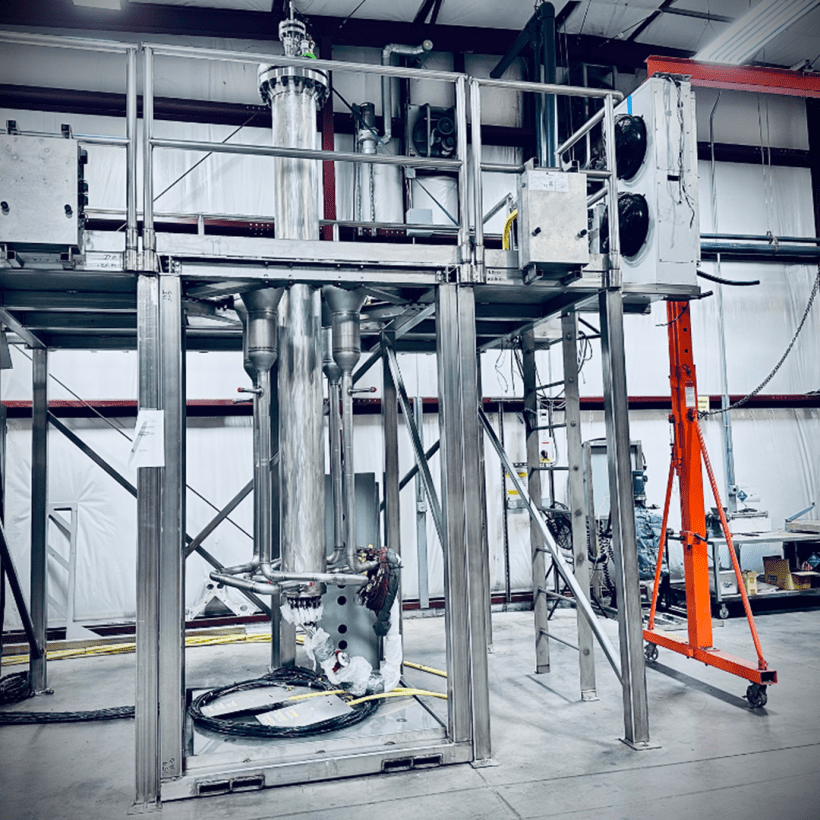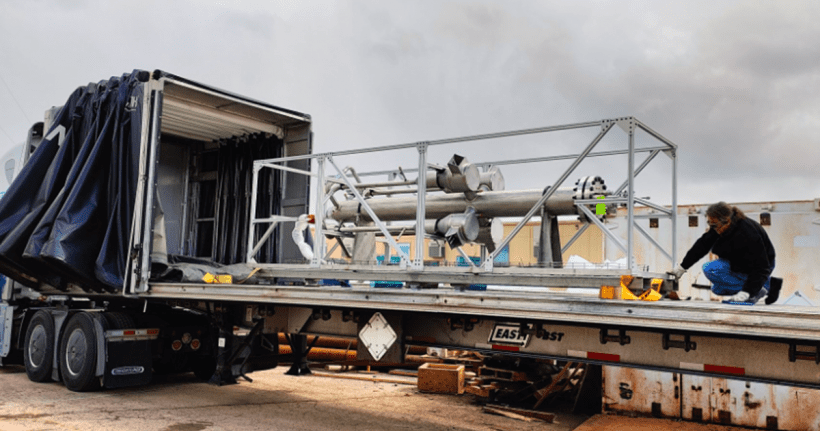DOE: MARVEL Microreactor Prototype Installed, Gearing Up for Testing
A full-scale electrically heated prototype of the Department of Energy’s (DOE’s) 100-kWth MARVEL nuclear microreactor has been successfully installed at a facility in New Freedom, Pennsylvania, and is readying for testing.
Idaho National Laboratory (INL) fabricated the full-scale non-nuclear prototype—known as the primary coolant apparatus test (PCAT)—in January 2022 within nine months. PCAT was then loaded onto a truck and transported from INL’s Materials and Fuels Complex (MFC) in Idaho Falls to a manufacturing facility owned by specialized engineering firm Creative Engineers Inc. (CEI) in Pennsylvania. Installation of the prototype into a two-story frame has now been completed, the DOE said on May 22.

PCAT, which measures 12 feet tall and weighs about 2,000 pounds, is a significant developmental step in the DOE’s April 2021-launched Microreactor Applications Research Validation and Evaluation (MARVEL) project. Led by INL, the MARVEL’s project key objective is to build and safely operate a 100-kW sodium-potassium-cooled reactor at INL’s Transient Reactor Test (TREAT) facility. MARVEL is on track to begin operation at TREAT by the end of 2024.
“When the MARVEL reactor comes online next calendar year, it will have been 50 years since we operated a new reactor on this site,” INL Director Dr. John Wagner told POWER during an INL site visit in April. “What we’re talking about here is historic in the U.S., and urgent in terms of demand for clean energy.”
Small Reactor, Big Possibilities
MARVEL, a thermal fission reactor, will use a uranium zirconium hydride (U-ZrHx) fuel (containing 30-40 wt% uranium that is enriched with 19.75% U235). The fuel is based on a well-known Training, Research, Isotopes, General Atomics (TRIGA) fuel material. INL intends to manufacture the fuel using uranium feedstock stores. If INL cannot manufacture the fuel, TRIGA International will manufacture fuel for the microreactor from DOE-owned feedstock stored at INL, a final environmental assessment, issued in June 2021, suggests.
The reactor will employ natural circulation, using sodium-potassium eutectic as its heat transfer fluid. It will operate at temperatures of between 500C to 550C and utilize off-the-shelf Stirling engines to convert thermal energy for about 20 kWe. The DOE suggests the system’s core is designed to operate continuously for two years, but the reactor will likely be turned on and off numerous times during its lifetime to support research needs.
PCAT, meanwhile, is a full-scale prototype that will be powered by an external electrical power supply instead of fission, and which will serve to collect crucial data on the system’s temperatures and coolant flow. According to the DOE, the information will ensure the accuracy of MARVEL’s modeling and simulation tools, which is “an important step in ensuring that the reactor will perform as expected,” the agency said.

The effort is geared to provide more certainty that the final reactor will perform to a high degree of reliability and confidence. noted Yasir Arafat, MARVEL’s chief design and project lead. “Validation of our physics models is critical to nuclear quality assurance for any new reactor development project,” Arafat said. “PCAT will generate this first-of-a kind-data for validating our thermal-hydraulics simulation tools and quantifying uncertainty for liquid metal thermal reactors, like MARVEL.”
According to the DOE, PCAT testing could begin “as early as July.” PCAT “will likely remain at CEI until the operation of MARVEL begins to provide further simulation and testing,” the agency noted. Once the MARVEL microreactor is active as anticipated in 2024, PCAT may be returned to INL to be used for additional research to help advance microreactor technologies, the agency added.
MARVEL’s development is notably progressing alongside Project Pele, the Department of Defense’s strategic project to develop a mobile microreactor technology, with a prototype set to be demonstrated at INL by 2024. Project Pele, a “single prototype” that is designed to deliver 1 MWe to 5 MWe for a minimum of three years of full power operation, will be a high-temperature gas reactor that will use high-assay low enriched uranium (HALEU) Tristructural Isotropic (TRISO) fuel.
MARVEL’s mission, however, is oriented toward industry progress. The program is slated to be a pivotal instrument in microreactor testing, development, and demonstration.
As a first-of-its-kind installation, MARVEL will provide insight into issues and challenges related to fabrication, assembly, rapid installation, deployment, authorization, and operation. That will include insights that could boost regulatory approval processes, such as microreactor siting and environmental reviews.
When operational, MARVEL will also explore autonomous operation technologies, and it will serve an integral role as part of INL’s nuclear microgrid. R&D efforts will explore applications such as load-following, process heat, hydrogen production, and water purification, the DOE has said.
—Sonal Patel is a POWER senior associate editor (@sonalcpatel, @POWERmagazine).